Beijing and Tibet are two completely different worlds with incredible cultural contrast, which is the best highlight to experience in this tour. You will start your adventure with a wonderful Beijing city tour, then take a flight to Lhasa directly (about 4.5 hours). While in Tibet, you will have an in-depth Discovery Tour taking the most class route from Lhasa to Everest. Tibetan culture, architecture, history, landscape... there are so many to explore.
Highlights of this tour:
- Explore the world-famous Heritage Sites in Beijing, including Forbidden City, Temple of Heaven, Great Wall, Summer Palace, etc.;
- Visit the most featured sites in Lhasa City, including Potala Palace, Jokhang Temple, Sera Monastery, etc.;
- Enjoy an adventure from Lhasa to the highest peak in the world - Mount Everest via Gyantse and Shigatse.
Tour Brief Information
- Tour price: from
- Tour code: TD-BT-12
- Tour Type: Private Customizable Tour Package
- Destination: Beijing / Lhasa / Shigatse / Everest / Lhasa
- Duration: 12 days and 11 nights
- Departure: Flexible
- Travel Theme:





- Best Time:



- Physical Level
- Tour Pace
- Max Altitude
5,200m
- Itinerary Details
- Price Guide & Booking
- Trip FAQs
- Reviews
- Make an Enquiry
Your tour - at a glance
Day 1~4 Arrival & Beijing Tour
Day 5~7 Lhasa City Tour
Day 8~11 Lhasa - Gyantse - Shigatse - Everest - Lhasa
Day 12 Lhasa Departure
Itinerary Details - Day by Day
Day 1 Beijing Arrival
Welcome to the capital city of China! Upon arriving at the airport/train station, you will be met by your local tour guide, and then drive to your downtown hotel in Beijing City. After the hotel check-in, you are free to take a rest or explore around on your own.
Day 2 Beijing ( B, L )
China has more than 4000 years’ history of Imperial Social System. While Beijing is the best place in China to experience the magnificent history and culture of ancient China. Today your guide will pick you up in the hotel after your breakfast, then start the wonderful ancient China culture and history tour!
You will firstly get to the world's largest plaza – Tian’anmen Sqaure. The grandiose Tianmen Gate was the place where the chairman Mao announced the establishement of the People’s Republic of China to the world. Passing through Tiananmen Gate, you will enter the splendid Forbidden City, the previous home to 24 emperors of Ming and Qing Dynasties for 600 years. Magnificent architectures, intricate ornaments and touching legends make it a must-see of China. In the afternoon, head to visit the stunning and exquisite Summer Palace, and be amazed at the vast ensemble of lakes, gardens, temples, and palaces, together as a masterpiece of Chinese landscape garden design. While in Qing Dynasty, it was the personal summer retreat for the royal families. It is made up of front hill, back hill and Kunming Lake. You will see splendid halls and pavilions in the front hill, while in the back hill, you will enjoy quiet and natural beauty.
After the sightseeing, you will be taken back to your hotel for rest.
-
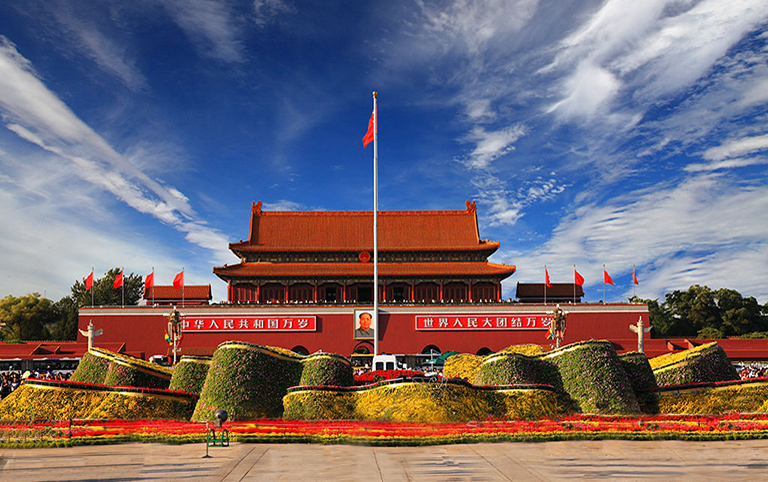 Tiananmen Square is a symbol of national cohesion
Tiananmen Square is a symbol of national cohesion
-
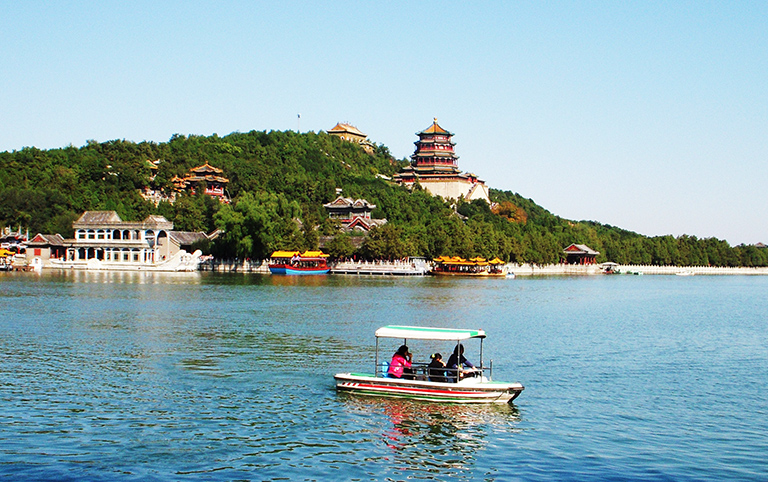 Appreciate the charm of royal garden
Appreciate the charm of royal garden
-
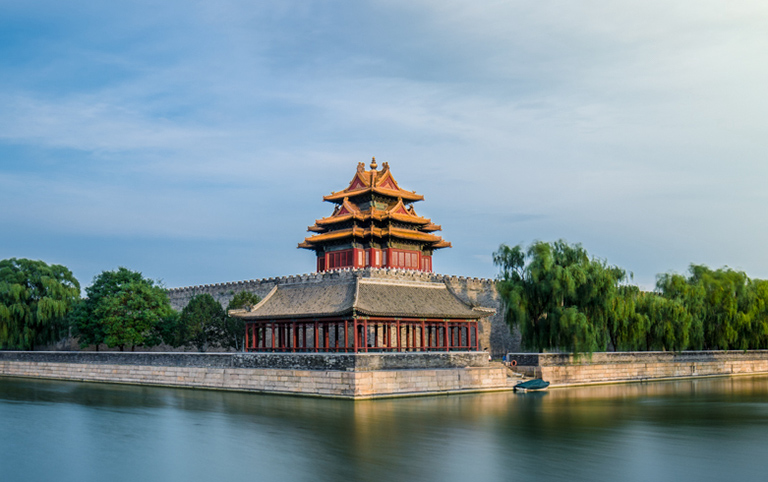
Day 3 Beijing ( B, L )
Hiking the Great Wall is one-in-a-lifetime thing to do for most travelers. Today, you are going to accomplish the Great Wall dream. You will be escorted about 70km from the downtown Beijing to the world-famous Mutianyu Great Wall which has fewer tourists compared with Badaling Great Wall. At the same time, it is the best Great Wall section to view the delicately beautiful scenery while appreciating the grandness of the Walls. After arriving at the ticket office, you will take a cable car to the walls of Mutianyu, and then hike about 2 hours on the Great Wall.
After the Mutianyu Great Wall hiking, you will drive back to the city. On route, take a sidetrip to the solemn Ming Tombs of ancient emperors in Ming Dynasty. Wander along the Sacred Road, a tranquil royal path featured with statues of divine animals and officials; also take an adventure to the mysterious Underground Palace. Before getting to your hotel, you will also make a stop at the Beijing Olympic Village to take some pictures of the world-famed "Bird’s Nest" and the "Water Cube" from the outside.
-
 Hiking on the beautiful Mutianyu Great Wall
Hiking on the beautiful Mutianyu Great Wall
-
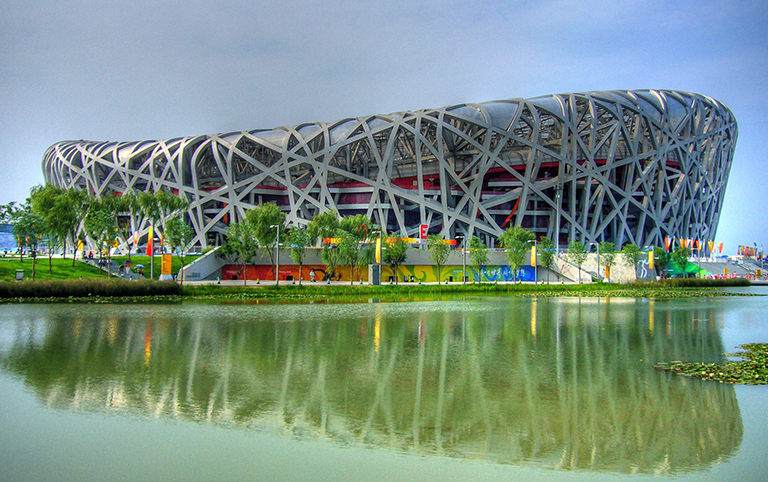 Have a Glimpse of the Bird's Nest
Have a Glimpse of the Bird's Nest
Day 4 Beijing ( B, L )
After breakfast, you'll have a visit to the charming Beihai Park to appreciate the beautiful White Pagoda and the Nine-Dragon Screen. Later move on to visit the most famous Hutongs which are some old alleys with traditional architecture originated from Yuan Dynasty (CD 1271~1368. Today, there are still many local Beijingers living in these old quarters, while in the Qing Dynasty (CD 1636~1912), there were even some noble royal families resided here. You can wander leisurely around these narrow alleys to experience the original features of people’s living in old time, or take a relaxing rickshaw through. Lunch will be arranged at a local family. If you like, you can learn to cook some Chinese dumplings by yourself.
After the lunch, head to marvel at one of the greatest masterpiece in Chinese architecture history - the Temple of Heaven, where the ancient emperors used to preside at various rituals for a national good harvest in ancient times. Today, the outer area of the Temple of Heaven is a public park for locals to gather to play Taichi, fly kites, chatting… while the inner area is the historical site for tourists to learn about the ancient Chinese history and culture.
-
 Temple of Heaven Is A Masterpiece of Chinese Architecture
Temple of Heaven Is A Masterpiece of Chinese Architecture
-
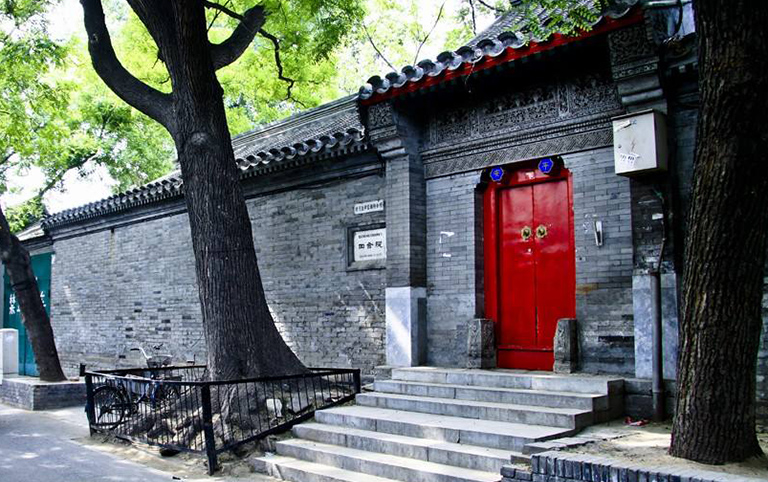
Day 5 Flight to Lhasa from Beijing ( B )
After breakfast, you'll be escorted to the airport and take a flight to Lhasa. Upon arriving at Lhasa Gonggar Airport, you will be picked up by local tour guide at the airport hall, then be escorted to your hotel in Lhasa city in a private vehicle. The rest of the day is free for you to explore the local areas and acclimatize yourself to the air, temperature and high altitude of Lhasa.
High Altitude Acclimation Tips:1) go for some leisure walking to acclimate the high altitude but avoid strenuous activity after arrival; 2) you'd better not have bath, in case of catching a cold; 3) drink more water, and have some fruit; 4) have a good rest.
Day 6 Lhasa ( B )
Start today’s Lhasa exploration with an exciting visit to the landmark - Potala Palace which is regarded as one of the most beautiful architectural building in the world. You will climb up the palace along the zigzag stone paths with white-and-red walls to the top of the palace where you can not only appreciate the exotic Tibetan-style architecture, but also get a great view of Lhasa’s urban areas, then walk into the inner space of Potala Palace to explore the stately chapels and learn about the history of the palace.
Continuing your exploration, you will then get to Jokhang Temple which is considered as the spiritual heart of Tibetan Buddhism. Each day, there are thousands of pilgrims coming from different places in Tibet to the temple to worship to the Buddha. This temple is also known as the “house of Buddha” because it keeps the precious Jowo Rinpoche, the life-sized (5 foot/1.5m) image of the Shakyamuni at the age of 12. The last site for today’s exploration is the famous Barkor Street. It is a circular and wide street encircling the Jokhang Temple. The local people like to walk on the street for several circles usually in the late afternoon as a daily tradition of pilgrimage. The street also has many shops selling a wide variety of traditional Tibetan goods, religious items and handcrafts.
Tips of today: 1) there are 1,080 steps up to climb to the top of Potala Palace, so don’t walk in a rush, which may cause high altitude sickness; 2) taking photos is not allowed inside the palace; 3) today you will be mainly outside, please bring some water, a hat, sun cream, and sun glasses with you.
-
 Admire the amazing appearance of Potala Palace
Admire the amazing appearance of Potala Palace
-
 Jokhang Temple Square
Jokhang Temple Square
-
 Local House by Barkhor Street
Local House by Barkhor Street
Day 7 Lhasa ( B )
After breakfast, you will firstly go to visit the beautiful Norbulingka which used to be the former summer palace of Dalai Lamas in the ancient time, and now is a public park. It is famous for its Potrang, the private palaces of former Dalai lamas with grandiose Tibetan architecture style. Next, drive several kilometers to the western outskirts of Lhasa to visit Drepung Monastery. Drepung, in Tibetan, means “prosperity”. Since its establishment, Drepung Monastery has always been one of the most important Buddhist monasteries in Tibet. In its heyday, there were more than 10,000 monks lived and studied in the monastery. Throughout its history, many important and famous Tibetan leaders used to study here, especially the Dalai Lamas. So Drepung Monastery is also respectfully known as the “Mother School of Dalai Lamas”.
In the afternoon, you will be taken to another famous monastery in Lhasa - Sera Monastery. It is famous for the spectacular “Buddhism Debating”. As a daily routine, the monks gather in a courtyard, and debate on the Buddhist doctrines with supplemented gestures, which is thought to be helpful to facilitates better comprehension of the Buddhist philosophy to attain higher levels of study. After enjoying the "Buddhism Debating", you will be transferred back to the city. The rest time is your own free time to rest.
The Etiquette of Visiting Monastery: 1) you shouldn’t wear short and uncover shoulders; 2) taking off your sunglasses and hat before entering the chapels; 3) taking photos is usually not allowed inside the chapels.
-
 Debating Monks
Debating Monks
-
 First Sight of Drepung Monastery
First Sight of Drepung Monastery
-
 Enjoy the bright flowers in Norblingka
Enjoy the bright flowers in Norblingka
Day 8 Lhasa - Gyantse - Shigatse / 360km, About 8hrs' Driving ( B )
Today, you will leave Lhasa and drive about 8 hours to Shigatse, the second largest city in Tibet. It may be a long journey, but there are many things to do along the road. The first site you will reach is the holy Yamdrok Lake (altitude: 4,400m). As the largest fresh lake in the northern of the Himalaya Mountains, it spreads about 675 square meters from south to north, like an eardrop lying in the arms of snow-capped giant mountains. Viewing from a distance, you can see fertile pastures full of yaks and sheep, and some small Tibetan villages along the lakeshore. Keeping driving not so far from Yamdrok Lake, you will see the imposing Karola Glacier (altitude: 5,045m) towering aloft on the right side of the road.
Continuing your trip, you will get to the historical city of Gyantse. Feel hungry? Have a good lunch in the town, then go to visit the mysterious Palcho Monastery (altitude: 4,040m). The monks and tradition of three important sects of Tibetan Buddhism - Sakyapa, Zhalupa and Gelukpa, peacefully coexist in this monastery. Its Kumbum, which is 35 meters high and has 76 small chapels with hundreds images of Kriyatantras , is believed to be the largest such structure in Tibet.
After the Gyantse sightseeing, keep drive about 3 hours, you will arrive at your hotel in Shigatse (altitude: 3,800m). Have a good rest!
Tips of today: 1) wear warm clothes to prevent from cold and wild; 2) pack some food and drinks with you because you will spend much time on the road.
-
 Yamdrok Lake is as beautiful as a sapphire
Yamdrok Lake is as beautiful as a sapphire
-
 White Pagoda of Palcho Monastery
White Pagoda of Palcho Monastery
-
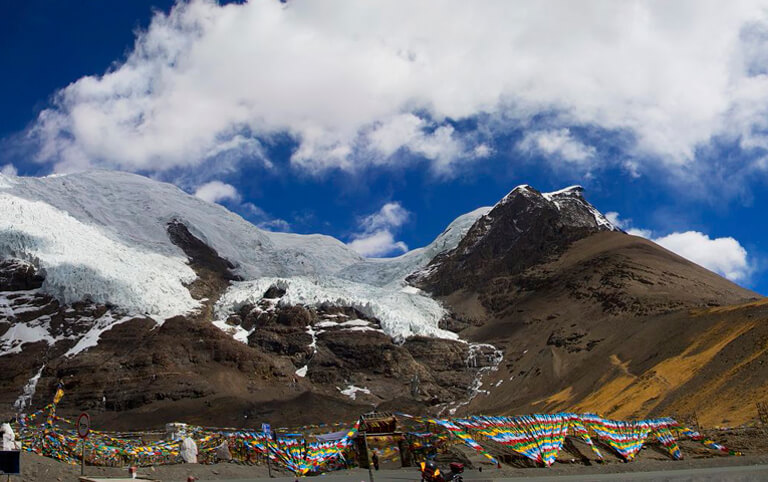 Get amazed by the stunning view of Karola Glaceier
Get amazed by the stunning view of Karola Glaceier
Day 9 Shigatse - Mount Everest / 350km, About 7hrs's Driving ( B )
Today, you will leave Shigatse for the final destination of your Tibet trip - Mount Everest. Though being a long driving of about 7 hours, but the views along the road are stupendous. As you reach Gawula Pass (5,250), you’ll feast your eyes on the fantastic view of Himalaya range including several famous peaks over 8,000 meters, including Mt. Makalu (8,463 m), Mt. Lhotse (8,516 m), Mt Everest (8,844 m), Mt. Cho Oyu (8,201 m) and Mt. Shishapama (8,020 m). When you finally get to the Rongbuk Monastery, and get the first sight of the mighty Everest, you will immerse in a solemn ethereal mood and find all the efforts you have made along the long way are not in vain. Located about 5100 meters above the sea level, Rongbuk Monastery is the highest monastery in the world. It is the best location to take some great photos of the front face of Mount Everest. The rest of today is free for you to visit the Rongbuk Monastery and explore the nearby Everest Base Camp. Take photos with the Everest altitude marker and EBC marker to commemorate your wonderful adventure tour.
Accommodation: if you visit Mount Everest during the off season (November to April), you will accommodate at Rongbuk Guest House near the Rongbuk Monastery; if you visit Mount Everest during the peak season (May to October), you will accommodate in a local Tibetan tent at Everest Base Camp which is only run between May and October by local Tibetans. It is near Rongbuk Monastery as well. Please note that the accommodation at both places is very simple and basic, only dorm beds with communal squat toilets are available. Duvets, heated blankets and hot water will be provided, and you are suggested to bring your own sleeping bag and toilet paper. There is no running water, sinks or showers. The dining room just offers basic breakfast and dinner without menu. Remember to dress warmly all the time.
Tips of today: bring a warm coat for low temperature in Everest and avoid strenuous activity to prevent from high altitude sickness.
-
 Rongbuk Monastery on the Mount Everest
Rongbuk Monastery on the Mount Everest
-
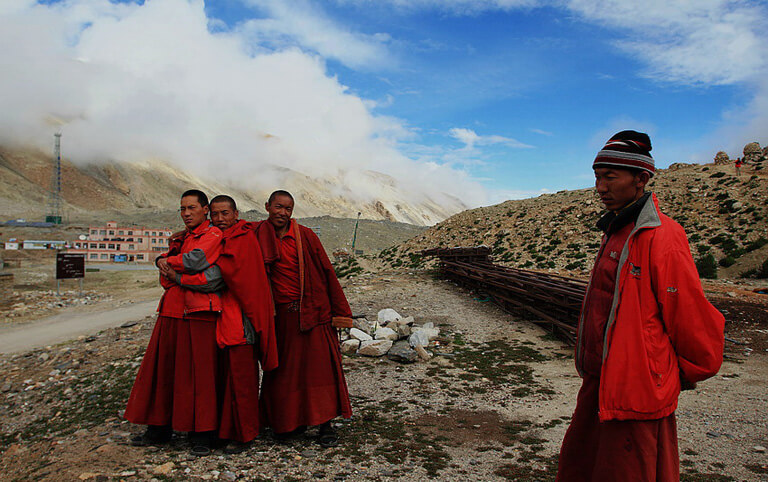 Tibetan Monks in Rongbuk Monastery on Mount Everest
Tibetan Monks in Rongbuk Monastery on Mount Everest
Day 10 Mount Everest - Shigatse / 350km, About 7hrs' Driving
Wake up early to enjoy the marvelous sunrise on the peak of the world. Then drive about 4km further to Tibetan Tents Camp (altitude: 4900m) where you can enjoy a closer view of Mount Everest.
The top part of the Mount Everest is always covered by snow all the year round, and when the sun shines on the mountain, the peak is like a giant white pyramid, which is one of the most famous sceneries of Mount Everest. In bright days, you can also see a wisp of cloud hanging above the top of Mount Everest. It flies eastward in the fast western wind just like a flapping flag. This unique phenomenon is the spectacular “Cloud Flag”. The cloud will change from surging waves into a thin cooking smoke or from galloping steeds into the mysterious veil of a goddess.
Till now your Mount Everest adventure is about to end. The rest of today is to drive back to Shigatse City. Have a good rest in Shigatse City.
Tips of today: 1) to protect the environment of Mount Everest, currently Everest Base Camp is not open for tourists – the Everest landscape can be enjoyed at Rongbuk Monastery and Tibetan Tent Camp as well. The base camp marker, a tablet reading “Mt. Qomolangma Base Camp” has been transferred to the Tibetan Tent Camp. You are suggested to take a photo at the marker to commemorate your wonderful adventure tour; 2) the sunrise usually starts around 6:30 am to 7am on Mount Everest; 3) keep warm all the time.
-
 Charming Sunrise on World Highest Mountain
Charming Sunrise on World Highest Mountain
-
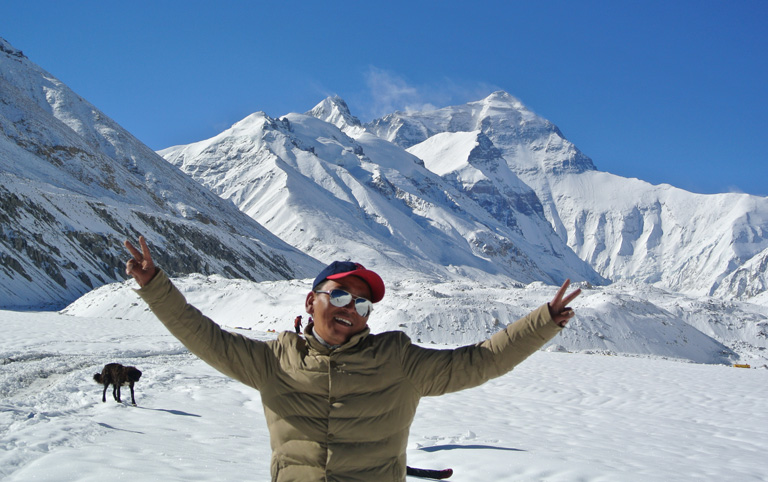 Our Tibetan Guide on Mount Everest
Our Tibetan Guide on Mount Everest
Day 11 Shigatse - Lhasa / 280km, About 6~7hrs' Driving ( B )
Today after breakfast, you will firstly take a visit to the official seat of Panchen Lama - Tashilhunpo Monastery which is also the largest and most influential Gelug Monastery in Shigatse prefecture. Here you will see a giant statue of Future Buddha, the largest one of its kind on earth ( 26.2 meters high and 11.5 meters wide ), decorated with precious pearls, turquoises, corals and ambers.
Then drive back to Lhasa (5 hours) along the legendary Yaluzangbu River, the mother river of Tibet. On the halfway, you will take a visit to Nyemo Tunba which was the home of Tunmi Sangbuzha who invented the Tibetan character as well as the famous Tibetan Tibetan Incense. Here in Tunba, you also have a chance to witness the process of making Tibetan Incense with water mill. At the same time, the scenery here is fabulous - ancient cypress trees, green willows, murmuring river...
Take a good rest in Lhasa.
-
 Qamba Buddha
Qamba Buddha
-
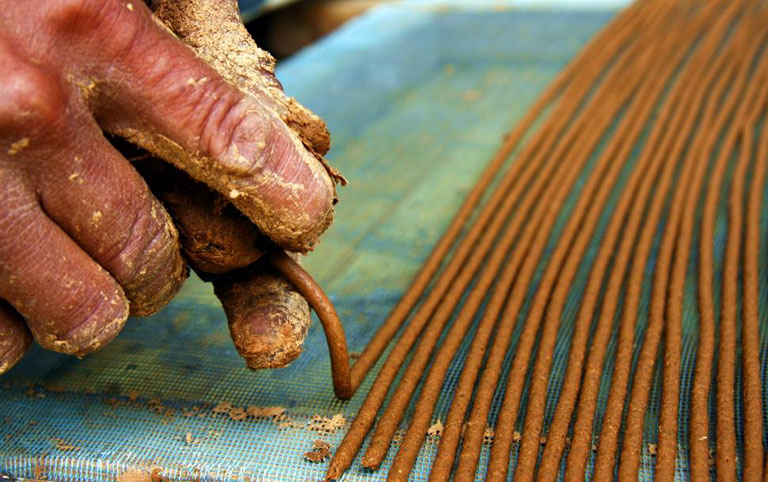 A worker is making Tibetan Incense
A worker is making Tibetan Incense
Day 12 Lhasa Departure ( B )
Today is free for you until your tour guide transfer you to the airport in time for your flight or drop you off at Lhasa train station.
Tips of Today: 1) please pack your luggage carefully, especially for small things like camera charger, power adaptor, mobile phone, phone charger, wallet and towel; 2) if your flight is arranged in the afternoon, please make sure you check out the hotel before 12pm.
Useful Trip Notes
-
- 1. Tibet Permits Guaranteed
To travel in Tibet, all Non-Chinese passport holders need to have a Tibet Travel Permit which is issued by Tibet Tourism Bureau in Lhasa. And only Chinese travel agencies like Tibet Discovery can apply for the permit on behalf of tourists. You must obtain it before your tour starting because the permit will be checked when you board your flight/train to Tibet. Traveling with Tibet Discovery, you don't have to worry about the complicated procedures of Tibet Travel Permit application. All you have to do is to confirm a tour package with us and send us your passport and Chinese visa copies at least 15~20 days in advance before your tour, then we will take care of all the rest things. Once the permit is issued, we will deliver to your address in China, such as your hotel, local travel agency, etc.
-
- 2. Available Months to Visit Tibet
Generally speaking, April to October is the best time. July and August are the peak season and rainy season. It is usually snowy and cold in winter, which is not suitable for visit Mount Everest, Namtso and Mount Kailash regions. While other places such as Lhasa, Gyantse and Shigatse are suitable for travel all year around. The temperatures in daytime and night differs a lot, usually 5~15℃ in the daytime and -5~0℃ in the night, so please wear accordingly.
-
- 3. High Altitude Sickness
The average altitude of Tibet is about 4000 meters above the sea level (Lhasa: 3700m; EBC: 5200m; Namtso: 4718m). You may suffer a bit from High Altitude Sickness in the beginning days of your Tibet trip if you haven’t had rich high plateau travel experience. But don’t worry too much, the high altitude can be acclimatized usually in 2~3 days. Our suggestion is to take a physical examination and get suggestions from your doctor, and also bring some medicines to prevent from High Altitude Sickness before your trip. While in Tibet, you should keep warm all the time, avoid strenuous activities, drink more water and eat more vegetables and carbohydrates. You’d better not take showers during the first two days after your arrival in Tibet. If you don’t feel well, get help from your tour guide or go to the hospital without any delay.
-
- 4. How to Go to Tibet
Basically you have two options – flight and train. Currently, you can take a flight to Lhasa from Beijing(4.5hrs), Xian(3.7hrs), Chengdu(2.5hrs), Chongqing(3hrs), Kunming(3hrs), Kathmandu (1.5hrs), etc. Among all these cities, Chengdu and Xian have more frequent flights to Lhasa.
If you prefer a train travel, you can take a train to Tibet from Beijing(40.5hrs), Xian(32hrs), Chengdu(43hrs), Shanghai(47hrs), Chongqing(42hrs), Lanzhou(25hrs), Xining(22hrs), Guangzhou(54hrs). -
- 5. Packing and Wearing Ideas
Firstly you can’t forget your passport and Chinese Visa. A large backpack and a smaller one are recommended (the smaller one can be used for daily activities). Also bring necessary medicine you need. Other stuffs like sunglasses, snow glasses, hats, lip balm, sun block are recommended.
As for wearing, you are suggested to dress in layers (both thin and thick jackets). Down jacket is necessary in Spring and Autumn. A pair of durable and comfortable shoes is necessary.
Recommended Tibet Group Tour Packages
Escorted by a skilled driver and companied by a professional local tour guide to organize all the activities, all you have to do is to enjoy your fantastic Tibet journey.Following are some other recommended Tibet group tour packages that you may be interested in. You can also contact us to customize a trip if you want..
-

Lhasa
4 Days Lhasa Tour from Beijing by Flight
Highlights: Potala Palace, Barkhor Street, Sera Monastery
-

Beijing / Lhasa
8 Days to See the Harsh Contrasts of Beijing and Tibet
Highlights: Forbidden City, Great Wall, Potala Palace, Barkhor Street
-

Beijing / Lhasa
8 Days Lhasa Tour from Beijing by Train
Highlights: Forbidden City, Great Wall, Potala Palace, Sera Monastery




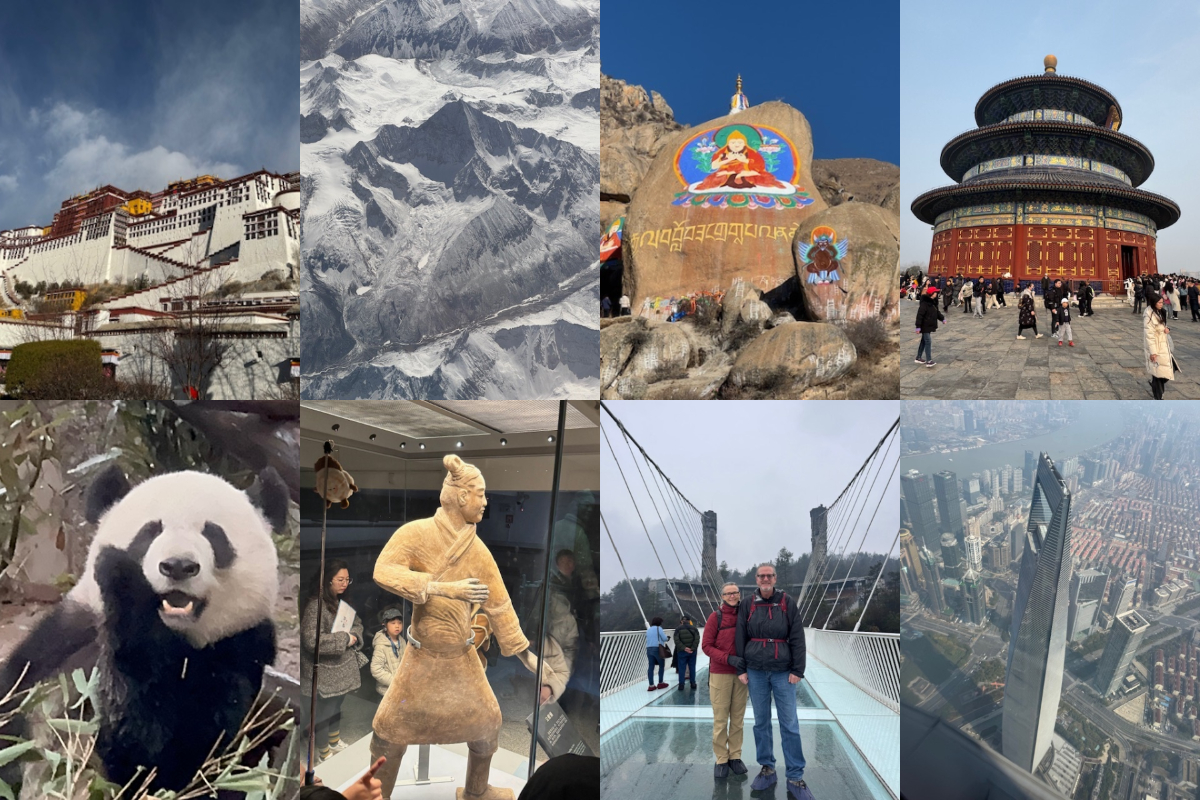

 Karen
Karen Wonder
Wonder Jack
Jack Rita
Rita Johnson
Johnson Vivien
Vivien Wing
Wing Ariel
Ariel Leo
Leo Tracy
Tracy Evelyn
Evelyn April
April Phoebe
Phoebe Kelly
Kelly Shirley
Shirley Reya
Reya Juliet
Juliet Elk
Elk Felix
Felix Sean
Sean